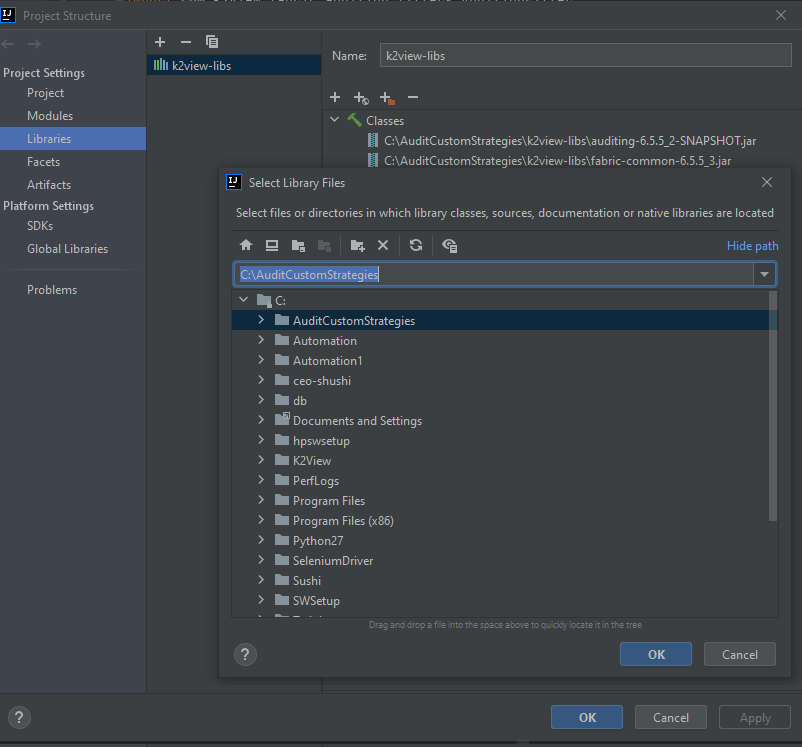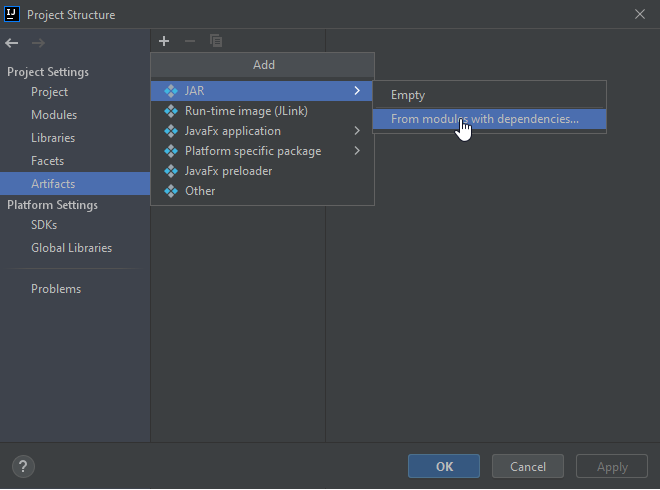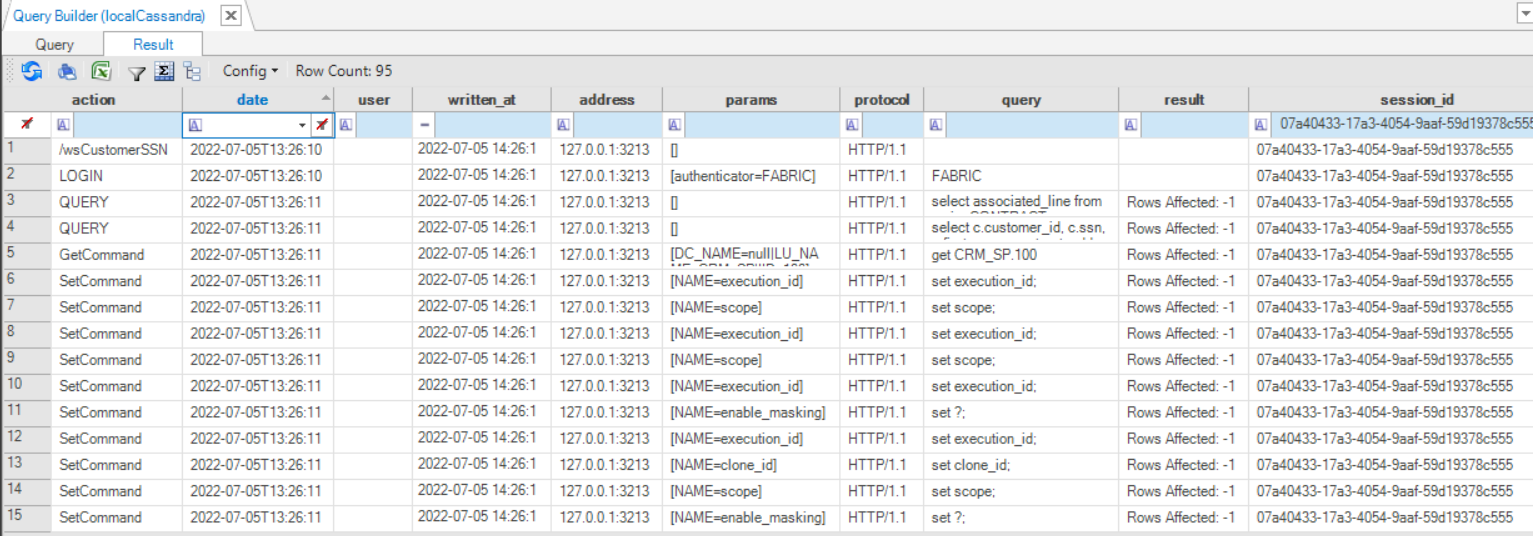Filtering Strategy
The list of activities reported by the Auditing mechanism can be controlled.
Once the AUDIT parameter is set to ON in config.ini, all Fabric activities are logged by the Fabric Auditing mechanism.
In order to limit the auditing to a specific predefined list of activities, the AUDIT_FILTER_STRATEGY parameter in the config.ini should be populated with the full path of the class defining the filter strategy.
How Can I Define the Auditing Filter?
In order to define the auditing filter, start from the sample provided as part of the Fabric installation and modify it according to your needs.
Alternatively, create a new class under the com.k2view.external.fabric.audit.filters folder. Note that the filter class should implement the com.k2view.external.fabric.audit.filters.AuditingFilter interface.
Take the following steps in order to build the artifacts:
Copy the project located under $K2_HOME/fabric/samples/AuditCustomStrategies locally.
- For example, copy from C:\K2View\Fabric_6.5\Server\fabric\samples\AuditCustomStrategies to your local AuditCustomStrategies directory.
Create a directory k2view-libs under AuditCustomStrategies directory.
Copy the files $K2_HOME/fabric/lib/fabric/fabric-common-[version-num].jar and auditing-[version-num].jar to your local k2view-libs folder.
Open IntelliJ IDE.
Import project AuditCustomStrategies via the IntelliJ menu File > New > Project from Existing Source.
Choose libraries either via the IntelliJ menu File > Project Structure or by typing CTRL+ALT+SHIFT+S.
In the Project Structure screen, click Libraries > the + sign > Java and select the above two Jars.

Click OK.
In the Project Structure screen, click Artifacts > the + sign > JAR > From modules with dependencies.

- Choose the Main class, which can be either All, filter strategies or persistency strategies.
- Click OK.
Click Build > Build Artifacts in IntelliJ menu and select the Build action.
The artifacts are created under the AuditCustomStrategies/out/artifacts folder.
Copy the created artifact JARs to the $K2_HOME/ExternalJars directory.
Update the config.ini file with the full path of the filtering class in the AUDIT_FILTER_STRATEGY parameter.
AUDIT_FILTER_STRATEGY=com.k2view.external.fabric.audit.filters.SampleFilterVerify that AUDIT is set to ON in the config.ini file.
AUDIT=ONRestart the Fabric node.
Example of Reporting Web Services Only
The following example displays the filter class com.k2view.external.fabric.audit.filters.SampleFilter that performs auditing of the Web Service calls only.
package com.k2view.external.fabric.audit.filters;
import com.k2view.fabric.common.Log;
import com.k2view.fabric.auditing.AuditBean;
import com.k2view.fabric.auditing.filters.AuditingFilter;
public class SampleFilter implements AuditingFilter {
@Override
public boolean filter(AuditBean auditBean) {
/*
\* Here you should add your code
\* When return false - the bean will not be audited
\* When return true - the bean will be audited
*/
if (auditBean.getAction().toLowerCase().contains("ws") || auditBean.getProtocol().toLowerCase().contains("http"))
{
Log.a(SampleFilter.class).info("Bean {} is passes the filter layer", auditBean.toString());
return true;
}
else
{
Log.a(SampleFilter.class).info("Bean {} is filtered out by the filter layer", auditBean.toString());
return false;
}
}
}
The WS calls are populated in the k2_auditing table in Cassandra as follows:

Filtering Strategy
The list of activities reported by the Auditing mechanism can be controlled.
Once the AUDIT parameter is set to ON in config.ini, all Fabric activities are logged by the Fabric Auditing mechanism.
In order to limit the auditing to a specific predefined list of activities, the AUDIT_FILTER_STRATEGY parameter in the config.ini should be populated with the full path of the class defining the filter strategy.
How Can I Define the Auditing Filter?
In order to define the auditing filter, start from the sample provided as part of the Fabric installation and modify it according to your needs.
Alternatively, create a new class under the com.k2view.external.fabric.audit.filters folder. Note that the filter class should implement the com.k2view.external.fabric.audit.filters.AuditingFilter interface.
Take the following steps in order to build the artifacts:
Copy the project located under $K2_HOME/fabric/samples/AuditCustomStrategies locally.
- For example, copy from C:\K2View\Fabric_6.5\Server\fabric\samples\AuditCustomStrategies to your local AuditCustomStrategies directory.
Create a directory k2view-libs under AuditCustomStrategies directory.
Copy the files $K2_HOME/fabric/lib/fabric/fabric-common-[version-num].jar and auditing-[version-num].jar to your local k2view-libs folder.
Open IntelliJ IDE.
Import project AuditCustomStrategies via the IntelliJ menu File > New > Project from Existing Source.
Choose libraries either via the IntelliJ menu File > Project Structure or by typing CTRL+ALT+SHIFT+S.
In the Project Structure screen, click Libraries > the + sign > Java and select the above two Jars.

Click OK.
In the Project Structure screen, click Artifacts > the + sign > JAR > From modules with dependencies.

- Choose the Main class, which can be either All, filter strategies or persistency strategies.
- Click OK.
Click Build > Build Artifacts in IntelliJ menu and select the Build action.
The artifacts are created under the AuditCustomStrategies/out/artifacts folder.
Copy the created artifact JARs to the $K2_HOME/ExternalJars directory.
Update the config.ini file with the full path of the filtering class in the AUDIT_FILTER_STRATEGY parameter.
AUDIT_FILTER_STRATEGY=com.k2view.external.fabric.audit.filters.SampleFilterVerify that AUDIT is set to ON in the config.ini file.
AUDIT=ONRestart the Fabric node.
Example of Reporting Web Services Only
The following example displays the filter class com.k2view.external.fabric.audit.filters.SampleFilter that performs auditing of the Web Service calls only.
package com.k2view.external.fabric.audit.filters;
import com.k2view.fabric.common.Log;
import com.k2view.fabric.auditing.AuditBean;
import com.k2view.fabric.auditing.filters.AuditingFilter;
public class SampleFilter implements AuditingFilter {
@Override
public boolean filter(AuditBean auditBean) {
/*
\* Here you should add your code
\* When return false - the bean will not be audited
\* When return true - the bean will be audited
*/
if (auditBean.getAction().toLowerCase().contains("ws") || auditBean.getProtocol().toLowerCase().contains("http"))
{
Log.a(SampleFilter.class).info("Bean {} is passes the filter layer", auditBean.toString());
return true;
}
else
{
Log.a(SampleFilter.class).info("Bean {} is filtered out by the filter layer", auditBean.toString());
return false;
}
}
}
The WS calls are populated in the k2_auditing table in Cassandra as follows:





